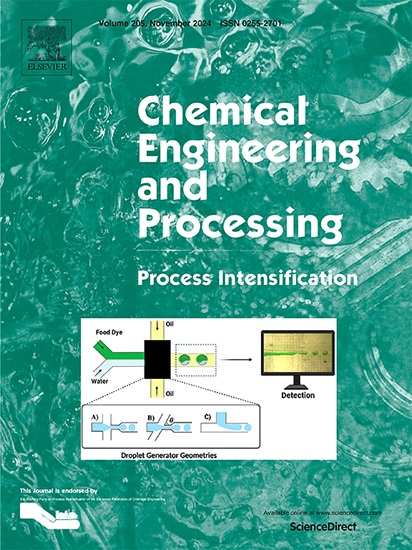Paired electrochemical synthesis of Cl2 from alkali chloride and CO from CO2
IF 3.8
3区 工程技术
Q3 ENERGY & FUELS
Chemical Engineering and Processing - Process Intensification
Pub Date : 2025-02-13
DOI:10.1016/j.cep.2025.110209
引用次数: 0
Abstract
In order to bring electrochemical CO2 reduction (eCO2R) to economical feasibility on an industrial scale, the conventional oxygen evolution reaction (OER) can be replaced with a value added reaction. In this work, we replace OER with chlorine evolution reaction (CER) in a paired synthesis with CO from CO2. Hereby, the reaction system is assessed at industrial relevant current densities with respect to electrolyte species & concentration and stability of up to 24 h. We report constant anodic FEs to Cl2 of 97 for up to 400 with concurrent FEs to CO of 90 at 100 and 74 at 200 over 4.5 h, significantly exceeding previous studies for comparable systems. The FE for CER did not show any decline over 24 h of operation. KCl showed superior results over NaCl and CsCl in terms of cathodic FE and cell potential. CER is affected by educt limitation with FE dropping below 95 at an electrolyte concentration of 0.8 mol/L at 400 . By successfully pairing eCO2R and CER with stable and high FEs at industrially relevant current densities, this work marks an important step towards an industrial application.

求助全文
约1分钟内获得全文
求助全文
来源期刊
CiteScore
7.80
自引率
9.30%
发文量
408
审稿时长
49 days
期刊介绍:
Chemical Engineering and Processing: Process Intensification is intended for practicing researchers in industry and academia, working in the field of Process Engineering and related to the subject of Process Intensification.Articles published in the Journal demonstrate how novel discoveries, developments and theories in the field of Process Engineering and in particular Process Intensification may be used for analysis and design of innovative equipment and processing methods with substantially improved sustainability, efficiency and environmental performance.

 求助内容:
求助内容: 应助结果提醒方式:
应助结果提醒方式:


